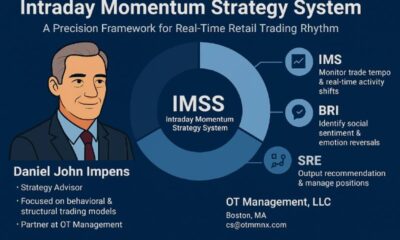Tech
How Bloggers Can Use Google Analytics to Analyze and Optimize Blog Performance

Understanding how your blog is performing is important to success in today’s digital world. Google Analytics is a useful tool that provides precise information about user behavior on your website. This tool allows bloggers to analyze statistics such as the number of visitors, the amount of time they spend on the site, and even the sources from which they come.
The appropriate use of Google Analytics can significantly improve your content strategy and help you make data-driven decisions. With so much data available, bloggers can determine which content is engaging and which is better. As a result, efforts can be more targeted, boosting the blog’s success and engagement.
Bloggers with a good understanding of the tool can not only track site performance, but also forecast future trends and plan the next steps. Google Analytics is more than simply a measurement tool; it’s essential to digital success.
What is Google Analytics?
Google Analytics is an advanced analytical tool that provides useful information about how well a website or blog is doing. The tool allows users to plan marketing strategies such as organic promotion, collect thorough information about site visitors, and understand their behavioral patterns. The tool includes numerous traffic measurement parameters to help you develop adapted content and identify successful articles, such as the number of visitors, pages visited, and average time spent on the site. Using Google Analytics, bloggers may improve their SEO methods, better target their efforts, increase reader engagement, and achieve more online success.
Setting up Google Analytics for your blog
Google Analytics is a vital tool for bloggers looking to monitor website performance and improve their techniques.
Create a Google Analytics account
To begin studying the data, create a Google Analytics account:
Visit the Google Analytics website and sign up for a new account.
Fill in the required information, such as the website’s name and URL.
Connecting the blog with Google Analytics
The link to Google Analytics is essential for gathering correct data and analyzing it to enhance blog promotion.
Add the tracking code
Google Analytics tracking code is embedded in the blog’s HTML file, namely in the section.
Google Tag Manager users create a new tag for the platform, then choose “Google Analytics: GA4 Configuration” and provide the property’s unique identification.
Using these settings, bloggers may execute organic promotion strategies while focusing their efforts on enhancing content and SEO.
Categories of data available via Google Analytics
Google Analytics offers detailed and useful data for assessing blog performance and boosting content and activity. This data is categorized into numerous categories to facilitate analysis and discover trends and needs in the field of web promotion.
Visitor data
The overview report displays metrics such as the number of visitors, bounce rate, and average time spent on the website. The demographic report provides information about visitors’ ages, genders, and interests, allowing them to identify a target audience and arrange appropriate content. In addition, the return report assesses visitor loyalty through analyses of intent to return to the website.
Traffic sources
The traffic acquisition report highlights the sources: organic search, direct, referrals, and social networks. Understanding traffic sources allows you to find the most effective organic promotion channels and invest in them as you create your plan. The organic search traffic report provides information on keywords that drive website traffic, allowing you to focus on organic promotion.
User behavior
The All Pages report displays data for individual pages, including blog pages. The data includes page visits, average time spent on the page, and entrances and exits. Analyzing user behavior allows us to discover what content piques people’s attention and change content strategy accordingly.
Using data to analyze blog performance
Analyzing blog performance in Google Analytics provides a complete view of how users engage with blog content. Gaining insight from these reports is crucial to enhancing both the blog’s success and user experience.
Identify popular content
To identify popular content, you can filter Google Analytics statistics to show only blog activity. The “All Pages” report allows you to filter by path /blog/ to gain more specific insights into popular postings. Another option is to use GA4 in the “Pages and Screens” report, which will show you which blog entries receive the most views and interactions. This allows you to focus your website promotion efforts on the content that generates the most engagement.
Recognizing user behavior and enhancing the blog experience
Google Analytics real-time reports and traffic acquisition provide helpful details about the sources of traffic and the current number of visitors to the website. By examining these patterns of behavior, it is possible to determine whether the traffic is coming from direct, organic, or referral sources. This allows for the content to be adjusted to improve the user experience. This data also aids in the analysis of the blog’s organic promotion and the strategic planning of its content.
Tips for Effective Use of Google Analytics
Advanced Data Segmentation
Data segmentation enables a thorough insight into blog visitor interactions. Data segmentation enables a thorough insight into blog visitor interactions. The data can be organized by content type, specific page, device, and platform. For example, studying interaction patterns on different blog pages allows you to determine which content attracts the most users and sparks curiosity. Sub-assets and super-assets make it easier to gain accurate insights and organize information. These tools provide an advantage when it comes to advertising websites and discovering content that boosts user engagement.
Tracking Conversions and Goals
Google Analytics allows you to effectively track conversions and goals on your site. The effectiveness of a marketing strategy can be measured by specifying objectives such as purchases, newsletter subscriptions, or other behaviors. Bloggers, for example, might evaluate subscriber data and optimize content that supports subscriptions to increase newsletter subscribers. While meeting the specified objectives, the conversion data and goals reveal how to focus efforts on organic promotion and content enhancement.
-

 Sports4 weeks ago
Sports4 weeks agoFIFA Club World Cup 2025: Complete List of Qualified Teams and Groups
-

 Sports3 weeks ago
Sports3 weeks agoAl Ahly vs Inter Miami, 2025 FIFA Club World Cup – Preview, Prediction, Predicted Lineups and How to Watch
-
Health1 week ago
Back to Roots: Ayurveda Offers Natural Cure for Common Hair Woes
-

 Tech2 weeks ago
Tech2 weeks agoFrom Soil to Silicon: The Rise of Agriculture AI and Drone Innovations in 2025
-

 Sports3 weeks ago
Sports3 weeks agoFIVB Men’s Volleyball Nations League 2025: Full Schedule, Fixtures, Format, Teams, Pools and How to Watch
-

 Startup3 weeks ago
Startup3 weeks agoHow Instagram Is Driving Global Social Media Marketing Trends
-

 Television4 weeks ago
Television4 weeks agoTribeca Festival 2025: Date, Time, Lineups, Performances, Tickets and How to Watch
-

 Sports3 weeks ago
Sports3 weeks agoWorld Judo Championships 2025: Full Schedule, Date, Time, Key Athletes and How to Watch























